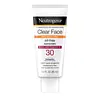What's inside
What's inside
 Key Ingredients
Key Ingredients

 Benefits
Benefits

 Concerns
Concerns

 Ingredients Side-by-side
Ingredients Side-by-side

Zinc Oxide 24.08%
Cosmetic ColorantWater
Skin ConditioningC12-15 Alkyl Benzoate
AntimicrobialIsopropyl Palmitate
EmollientButyloctyl Salicylate
Skin ConditioningEthylhexyl Isononanoate
EmollientCetyl PEG/PPG-10/1 Dimethicone
EmulsifyingPropylene Glycol
HumectantCyclopentasiloxane
EmollientBis-Octyldodecyl Dimer Dilinoleate/Propanediol Copolymer
EmollientDimethicone
EmollientEthylhexyl Methoxycrylene
Skin ConditioningPolyester-27
Camellia Sinensis Leaf Extract
AntimicrobialMacrocystis Pyrifera Extract
Skin ConditioningNelumbo Nucifera Extract
Skin ConditioningTriethoxycaprylylsilane
Beeswax
Emulsion StabilisingHydroxyacetophenone
AntioxidantPEG-12 Dimethicone Crosspolymer
EmulsifyingTocopherol
Antioxidant1,2-Hexanediol
Skin ConditioningCaprylyl Glycol
EmollientSodium Chloride
MaskingZinc Oxide 24.08%, Water, C12-15 Alkyl Benzoate, Isopropyl Palmitate, Butyloctyl Salicylate, Ethylhexyl Isononanoate, Cetyl PEG/PPG-10/1 Dimethicone, Propylene Glycol, Cyclopentasiloxane, Bis-Octyldodecyl Dimer Dilinoleate/Propanediol Copolymer, Dimethicone, Ethylhexyl Methoxycrylene, Polyester-27, Camellia Sinensis Leaf Extract, Macrocystis Pyrifera Extract, Nelumbo Nucifera Extract, Triethoxycaprylylsilane, Beeswax, Hydroxyacetophenone, PEG-12 Dimethicone Crosspolymer, Tocopherol, 1,2-Hexanediol, Caprylyl Glycol, Sodium Chloride
Butyl Methoxydibenzoylmethane 2.5%
UV AbsorberHomosalate 8%
Skin ConditioningEthylhexyl Salicylate 5%
UV AbsorberOctocrylene 8%
UV AbsorberWater
Skin ConditioningSilica
AbrasiveCetyl Dimethicone
EmollientStyrene/Acrylates Copolymer
C12-15 Alkyl Benzoate
AntimicrobialEthylhexylglycerin
Skin ConditioningSteareth-100
Gel FormingAluminum Starch Octenylsuccinate
AbsorbentPhenoxyethanol
PreservativeCaprylyl Glycol
EmollientSodium Polyacrylate
AbsorbentDimethicone
EmollientPolyester-7
Skin ConditioningChlorphenesin
AntimicrobialSteareth-2
EmulsifyingEthylhexyl Stearate
EmollientDisodium EDTA
Propylene Glycol
HumectantNeopentyl Glycol Diheptanoate
EmollientBisabolol
MaskingAcrylates/Dimethicone Copolymer
Skin ConditioningButylene Glycol
HumectantBHT
AntioxidantMannan
Xanthan Gum
EmulsifyingCapryloyl Glycine
CleansingTrideceth-6
EmulsifyingSarcosine
Skin ConditioningCedrus Atlantica Bark Extract
PerfumingCinnamomum Zeylanicum Bark Extract
AntimicrobialPortulaca Oleracea Extract
Skin ConditioningButyl Methoxydibenzoylmethane 2.5%, Homosalate 8%, Ethylhexyl Salicylate 5%, Octocrylene 8%, Water, Silica, Cetyl Dimethicone, Styrene/Acrylates Copolymer, C12-15 Alkyl Benzoate, Ethylhexylglycerin, Steareth-100, Aluminum Starch Octenylsuccinate, Phenoxyethanol, Caprylyl Glycol, Sodium Polyacrylate, Dimethicone, Polyester-7, Chlorphenesin, Steareth-2, Ethylhexyl Stearate, Disodium EDTA, Propylene Glycol, Neopentyl Glycol Diheptanoate, Bisabolol, Acrylates/Dimethicone Copolymer, Butylene Glycol, BHT, Mannan, Xanthan Gum, Capryloyl Glycine, Trideceth-6, Sarcosine, Cedrus Atlantica Bark Extract, Cinnamomum Zeylanicum Bark Extract, Portulaca Oleracea Extract
 Reviews
Reviews

Ingredients Explained
These ingredients are found in both products.
Ingredients higher up in an ingredient list are typically present in a larger amount.
C12-15 Alkyl Benzoate is made up of Benzoic Acid and long chain alcohols. It has a low molecular weight.
C12-15 Alkyl Benzoate is an emollient and texture enhancer. Due to its solubility, it is often used in sunscreens to help evenly distribute active ingredients.
As an emollient, C12-15 Alkyl Benzoate helps soften and hydrate your skin. Emollients create a film on your skin that traps moisture within.
This ingredient has been reported to cause eye irritation.
Learn more about C12-15 Alkyl BenzoateCaprylyl Glycol is a humectant and emollient, meaning it attracts and preserves moisture.
It is a common ingredient in many products, especially those designed to hydrate skin. The primary benefits are retaining moisture, skin softening, and promoting a healthy skin barrier.
Though Caprylyl Glycol is an alcohol derived from fatty acids, it is not the kind that can dry out skin.
This ingredient is also used as a preservative to extend the life of products. It has slight antimicrobial properties.
Learn more about Caprylyl GlycolDimethicone is a type of synthetic silicone created from natural materials such as quartz.
What it does:
Dimethicone comes in different viscosities:
Depending on the viscosity, dimethicone has different properties.
Ingredients lists don't always show which type is used, so we recommend reaching out to the brand if you have questions about the viscosity.
This ingredient is unlikely to cause irritation because it does not get absorbed into skin. However, people with silicone allergies should be careful about using this ingredient.
Note: Dimethicone may contribute to pilling. This is because it is not oil or water soluble, so pilling may occur when layered with products. When mixed with heavy oils in a formula, the outcome is also quite greasy.
Learn more about DimethiconePropylene Glycol is an odorless, colorless liquid. As a humectant, it helps skin retain moisture. It also aids in delivering active ingredients.
Another role of this ingredient is preventing a product from melting or freezing. Propylene glycol also adds antimicrobrial properties to a product, elongating product lifespan.
This ingredient is considered an organic alcohol and commonly added into both cosmetics and foods.
Those with sensitive skin or conditions may develop a rash when using this ingredient.
Learn more about Propylene GlycolWater. It's the most common cosmetic ingredient of all. You'll usually see it at the top of ingredient lists, meaning that it makes up the largest part of the product.
So why is it so popular? Water most often acts as a solvent - this means that it helps dissolve other ingredients into the formulation.
You'll also recognize water as that liquid we all need to stay alive. If you see this, drink a glass of water. Stay hydrated!
Learn more about Water